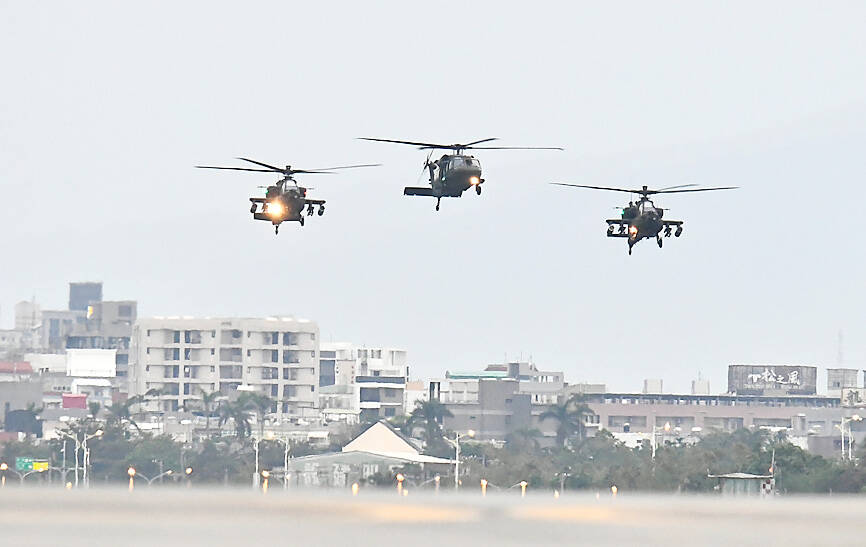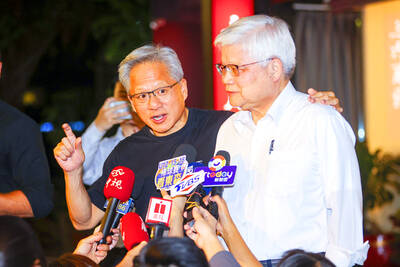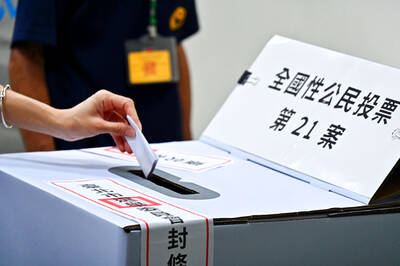The army is seeking to purchase an additional 30 Sikorsky UH-60 Armed Black Hawk helicopters, as well as looking into upgrading its fleet of UH-60M Black Hawks with Hellfire missiles, rockets and autocannons, a source with knowledge of the matter said yesterday on condition of anonymity.
The army has a surplus of AGM-114 Hellfire missiles, but lacks sufficient platforms outside the Boeing AH-64 Apache, the Bell AH-1 Cobra and the Bell OH-58 Kiowa, the source said.
Despite their superior numbers within the army, the UH-60 does not possess the racks and system to attach and fire missiles, the source said.

Photo: Yu Tai-lang, Taipei Times
The nation fields 58 Black Hawks, of which 30 were assigned to the army, 14 to the air force and 14 to the Ministry of the Interior’s National Air Service Corps, the source said.
Taiwan purchased 60 helicopters from the US, but two have crashed, with one of the incidents in 2020 resulting in the death of eight people, including Taiwan’s then-chief of the general staff General Shen Yi-ming (沈一鳴), the nation’s most senior military official ever killed in such an incident.
The army received UH-60Ms, which can deploy two machine guns, while the National Air Service Corps’ craft were outfitted with infrared scanning equipment before delivery.
The military is looking into ways that would allow the army to deploy sufficient helicopters in the event of losses in a conflict, the source said.
The military expressed interest in acquiring the Armed Black Hawk version after Lockheed Martin’s Sikorsky, the manufacturer, in September last year released footage of live-fire exercises in Arizona conducted by the variant.
The video showed a pilot with an ANVIS/HUD-24 helmet-mounted display and tracker system, with the helicopter carrying an electro-optical infrared sensor on the nose, M134 7.62mm mini-guns at each cabin door, a pair of GAU-19 .50 Gatling guns, a 70mm Hydra rocket pod and a rack of AGM-114 Hellfire missiles.

Chinese Nationalist Party (KMT) lawmakers have declared they survived recall votes to remove them from office today, although official results are still pending as the vote counting continues. Although final tallies from the Central Election Commission (CEC) are still pending, preliminary results indicate that the recall campaigns against all seven KMT lawmakers have fallen short. As of 6:10 pm, Taichung Legislators Yen Kuan-heng (顏寬恒) and Yang Chiung-ying (楊瓊瓔), Hsinchu County Legislator Lin Szu-ming (林思銘), Nantou County Legislator Ma Wen-chun (馬文君) and New Taipei City Legislator Lo Ming-tsai (羅明才) had all announced they

CHAMPIONS: President Lai congratulated the players’ outstanding performance, cheering them for marking a new milestone in the nation’s baseball history Taiwan on Sunday won their first Little League Baseball World Series (LLBWS) title in 29 years, as Taipei’s Dong Yuan Elementary School defeated a team from Las Vegas 7-0 in the championship game in South Williamsport, Pennsylvania. It was Taiwan’s first championship in the annual tournament since 1996, ending a nearly three-decade drought. “It has been a very long time ... and we finally made it,” Taiwan manager Lai Min-nan (賴敏男) said after the game. Lai said he last managed a Dong Yuan team in at the South Williamsport in 2015, when they were eliminated after four games. “There is

Nvidia Corp CEO Jensen Huang (黃仁勳) yesterday visited Taiwan Semiconductor Manufacturing Co (TSMC, 台積電), as the chipmaker prepares for volume production of Nvidia’s next-generation artificial intelligence (AI) chips. It was Huang’s third trip to Taiwan this year, indicating that Nvidia’s supply chain is deeply connected to Taiwan. Its partners also include packager Siliconware Precision Industries Co (矽品精密) and server makers Hon Hai Precision Industry Co (鴻海精密) and Quanta Computer Inc (廣達). “My main purpose is to visit TSMC,” Huang said yesterday. “As you know, we have next-generation architecture called Rubin. Rubin is very advanced. We have now taped out six brand new

POWER PLANT POLL: The TPP said the number of ‘yes’ votes showed that the energy policy should be corrected, and the KMT said the result was a win for the people’s voice The government does not rule out advanced nuclear energy generation if it meets the government’s three prerequisites, President William Lai (賴清德) said last night after the number of votes in favor of restarting a nuclear power plant outnumbered the “no” votes in a referendum yesterday. The referendum failed to pass, despite getting more “yes” votes, as the Referendum Act (公民投票法) states that the vote would only pass if the votes in favor account for more than one-fourth of the total number of eligible voters and outnumber the opposing votes. Yesterday’s referendum question was: “Do you agree that the Ma-anshan Nuclear Power Plant